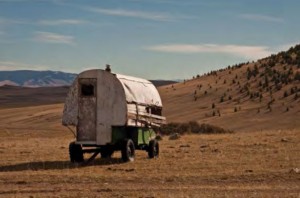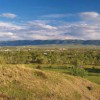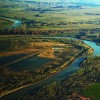Wandering down the spine of a ridge last summer in southern Wyoming’s Sierra Madre, I stumbled across a 100-year-old mining camp: pits surrounded by heaps of broken rock, heavy rusted cable snaking through the underbrush, and the collapsed beams of a tram tower that once carried copper ore 16 miles to the smelter in Riverside. At the turn of the century, 5,000 miners lived here at nearly 10,000 feet of elevation, working the Ferris-Haggerty Mine and adjacent claims. They harvested trees for lumber and fuel. By the end of 1908, the mines were done, the men moved on, the houses stood abandoned, and the forest started growing back.
 Today, backpackers hike the nearby Continental Divide Trail. Families buzz past on high-tech ATVs. Cabins sprout near the highway. The scene is a microcosm for a greater trend on western lands, where a new generation extracts new value from the land. The ranks of outdoor enthusiasts are growing as populations expand, and more people work indoors and enjoy their leisure time outside. And technological advances—mountain bike suspension, packrafts, dune buggies, etc.—make it easier to play deep in the backcountry.
Today, backpackers hike the nearby Continental Divide Trail. Families buzz past on high-tech ATVs. Cabins sprout near the highway. The scene is a microcosm for a greater trend on western lands, where a new generation extracts new value from the land. The ranks of outdoor enthusiasts are growing as populations expand, and more people work indoors and enjoy their leisure time outside. And technological advances—mountain bike suspension, packrafts, dune buggies, etc.—make it easier to play deep in the backcountry.
Some communities in the West are finding ways to capitalize on recreation. Take Casper, Wyoming, Oil City of the Plains. Today the town’s inhabitants may still work in the energy industry, but they also enjoy the town’s blue-ribbon fishery, trails system, and clear skies. The result is economic diversification and in some cases, increasing numbers of stewards compelled by a personal connection to the outdoors.
And yet, there are trade-offs. More visitors mean more encroachment into wild country. Even quiet backcountry skiers can disturb wildlife. As antler hunters descend on once-empty public lands in western Wyoming, they stress wintering mule deer and compete with hobbyist antler collectors.
This issue of Western Confluence examines outdoor tourism’s influence on local economies and the management challenges it presents. We also touch on some solutions, new ideas for protecting favorite places while pursuing outdoor tourism. The subject is huge, and our coverage is by no means comprehensive, but we hope to chip at its edges and provoke some new thinking.
Not far from the mining camp in the Sierra Madre, I passed a sheep wagon tucked into a stand of krumholz. Sheep bleated and nosed the mountain grass. Their shepherd sat horseback, resting his elbow on the saddle horn as he watched the flock. Even as the West changes, the ways of living off the land that Westerners have pursued for the last century are not going away. And tourism will raise some of the same questions as those other industries—how do we support the people who live here now while preserving the characteristics we love about these places for our children and grandchildren?
By Emilene Ostlind



After 25 years of unsuccessfully trying to answer that question I haven’t quit trying. To solve that problem requires looking decades in the future and like a pension invest in planned expected occurrences with out placing all your eggs in one basket. Two decades ago Wyoming should have planned and begun investing a good portion of the taxes collected from its non-renewable resources in renewable resources. We have a history of being more creative when we are struggling. Water, tourism, grasslands, forests, wind, wildlife, recreation and people are renewable resources. All of these resources need to be made more productive not less productive as has often been the case. Increasing productivity (creativity) in Wyoming’s renewable resources will create more jobs for our grand children and more income for Wyoming.
The Ruckelshause Institute, who took on this responsibility over two decades ago, has certainly failed the Wyoming community of Dubois. How is the rest of Wyoming doing?
I have appreciated reading Western Confluence as it relates much to my own experience here in Wyoming.
For example I to walked the ridge over the Ferris-Haggery mine in the late 1950s. I have in my possession one of the old oar buckets carried by the tram. I would enjoy seeing the new trees which have replaced the trees used to develop and maintain the copper mine. The trees are my passion today and these must now be 60 feet tall.
There is what I believe to be an untold story related to this old tramway. Because I have been learning and researching prisoner of war camps in Wyoming I learned that the Ryan Park prisoners helped to construct this ski area and the chair lift on Barret Ridge (mostly financed in part by the Sinclair Oil Refinery). The chair lift was constructed (late 1930s up to 1945) in part from the remains of the Ferris-Haggerty mine tram. It may be that the very existance of this ski area at Ryan Park, now gone, was the result of the Civilian Conservation Corp. labor,, the continued Italian and German prisoner of war labor and availability of materials from the Ferris Haggerty mine tram.
Bob Baker, Dubois